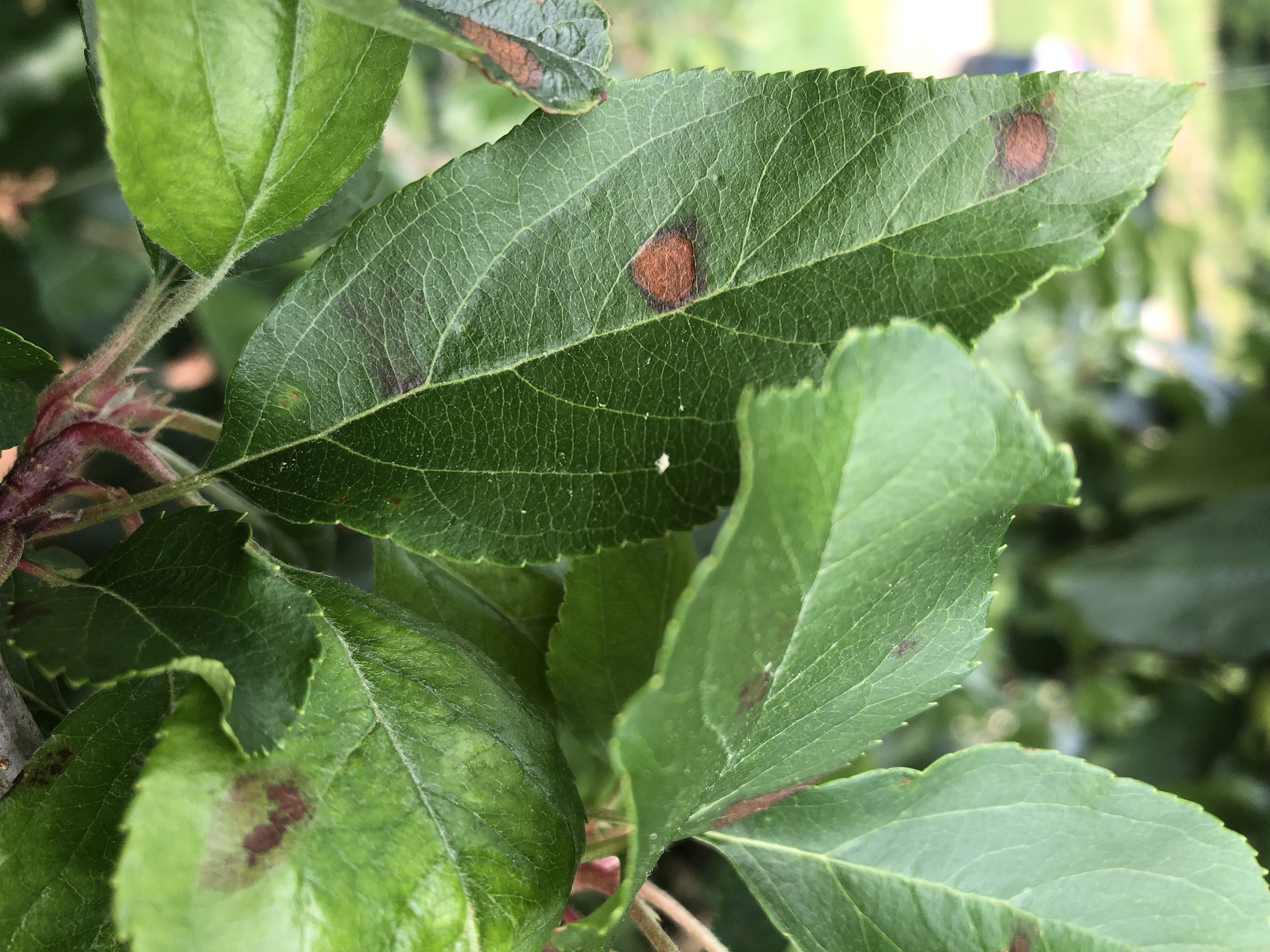Apple Disease Update: Week of May 29, 2022
go.ncsu.edu/readext?867868
en Español / em Português
El inglés es el idioma de control de esta página. En la medida en que haya algún conflicto entre la traducción al inglés y la traducción, el inglés prevalece.
Al hacer clic en el enlace de traducción se activa un servicio de traducción gratuito para convertir la página al español. Al igual que con cualquier traducción por Internet, la conversión no es sensible al contexto y puede que no traduzca el texto en su significado original. NC State Extension no garantiza la exactitud del texto traducido. Por favor, tenga en cuenta que algunas aplicaciones y/o servicios pueden no funcionar como se espera cuando se traducen.
Português
Inglês é o idioma de controle desta página. Na medida que haja algum conflito entre o texto original em Inglês e a tradução, o Inglês prevalece.
Ao clicar no link de tradução, um serviço gratuito de tradução será ativado para converter a página para o Português. Como em qualquer tradução pela internet, a conversão não é sensivel ao contexto e pode não ocorrer a tradução para o significado orginal. O serviço de Extensão da Carolina do Norte (NC State Extension) não garante a exatidão do texto traduzido. Por favor, observe que algumas funções ou serviços podem não funcionar como esperado após a tradução.
English
English is the controlling language of this page. To the extent there is any conflict between the English text and the translation, English controls.
Clicking on the translation link activates a free translation service to convert the page to Spanish. As with any Internet translation, the conversion is not context-sensitive and may not translate the text to its original meaning. NC State Extension does not guarantee the accuracy of the translated text. Please note that some applications and/or services may not function as expected when translated.
Collapse ▲As I’ve said since my third year in NC, Memorial Day is often the time I begin to see GLS symptoms appearing on leaves. Rachel, our program’s research assistant and I took a stroll through our “Glomerella Gala” research orchard and in some of the untreated trees, we did see some early symptoms popping up. This is not to alarm you, because the incidence is quite low, but rather to serve as a “gentle reminder” that either you hop on the GLS/bitter rot spray train now or you may be calling me near harvest that you’ve lost most of your fruit to bitter rot.
I’m happy to provide the proof from our research over the past five years of the importance to tight fungicide intervals from now through harvest, but don’t want the importance of my message to get lost in the weeds. So, here are the take-home messages and feel free to contact me directly (sara_villani@ncsu.edu) if you’d like to see the graphs and charts. If I’m at a blank on what to post one week, you may also see them then….
- DO NOT extend fungicide application intervals from now through harvest on ANY cultivar that is susceptible to GLS OR any cultivar that you consistently observe a lot of bitter rot (e.g. Honeycrisp). The old “14-21” spray interval guidance should be thrown out the window with these two diseases and with the highly susceptible cultivars we are growing in the region.
- That said, 7 to 10 day interval is the sweet spot. If its Honeycrisp or a block that has heavy GLS or bitter rot pressure in the past, err on the 7 day side. If we get a lot of precipitation, you may want to shorten this up even further on cultivars like HC. Studies have shown that it’s actually a single precipitation event that gets rid of most of the captan deposit from a single spray. The product tends to remain after that.
- Consider growth rate of the tree. Simply bet on the fact that any new foliage which comes out after you spray is not protected. UNLESS a protectant fungicide, like captan, is redistributed. This may mean perhaps going on a 7 day interval when you have a lot of new growth emerging. If you groan at this, perhaps a maintenance rate of prohexadione-calcium (Kudos, Apogee) should be considered.
- The most efficacious fungicides for managing GLS and bitter rot have been Mancozeb, captan, ziram (if surfactant is included according to research being conducted at PSU), and FRAC 11 fungicides: Pristine, Merivon, Flint Extra, Luna Sensation, the former two having better kickback activity. For those unfamiliar with kickback activity, this simply means that the product works after a spore lands and germinates. The strobilurins are “ok” in general in regards to kickback activity but I would not make a habit of this, nor would I go past 24 hours after an infection event.
- Captan alone (half rate) or Captan (half rate) plus ProPhyt (3 pt) or Captan (half rate) + Ziram 3 lb should be the backbone of your summer covers. Perhaps rotate between those three options. If you’re concerned about too much captan and hitting your annual limit, Ziram 4 lbs + surfactant or a strobilurin (listed above) plus Ziram 3 lbs are options.
- For resistance management: 1) make sure you are applying a strobilurin with a protectant fungicide (captan or ziram) and 2) No more than four applications of any of the following fungicides: Sovran, Flint Extra, Luna Sensation, Merivon, or Pristine. This means either the same product applied four times or in rotation with one of the other strobilurins.
- Keep humidity down in the orchard by keeping weeds and grass at a minimum



